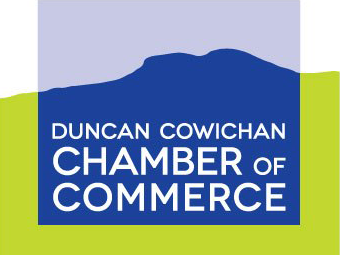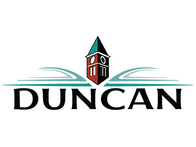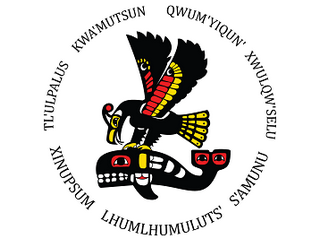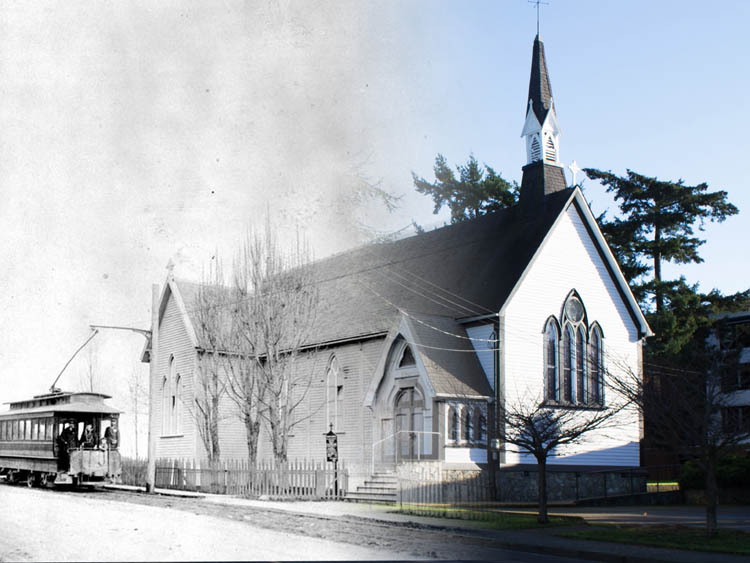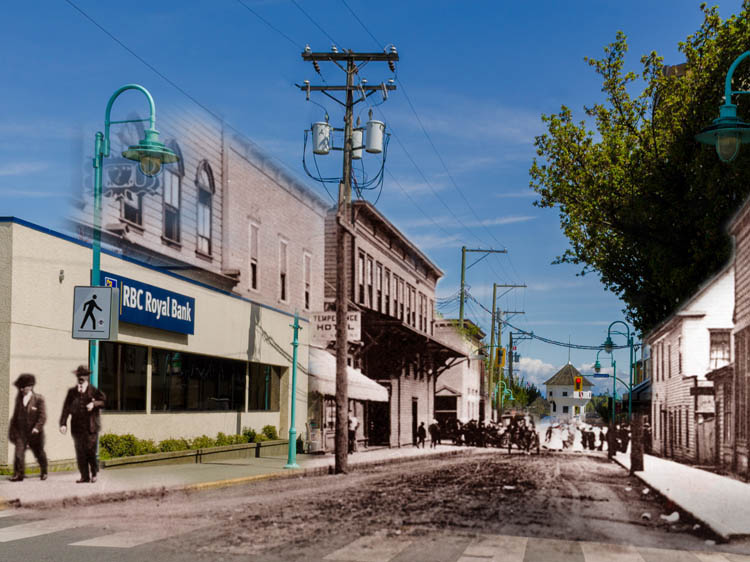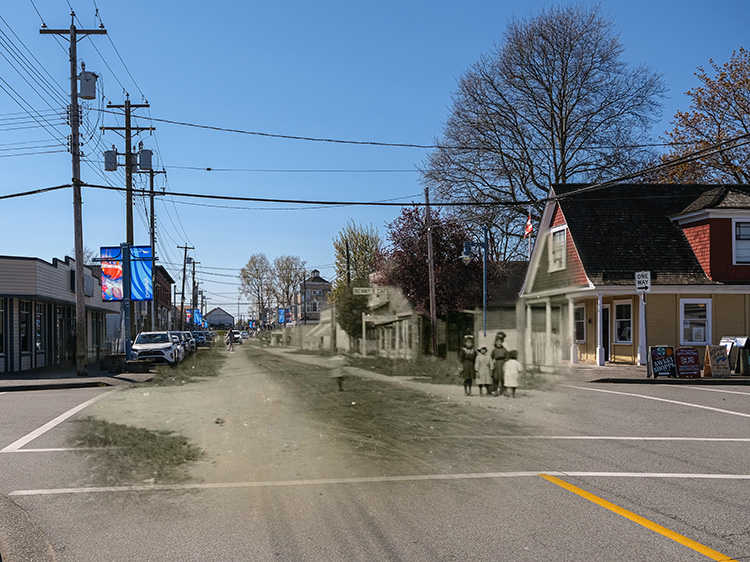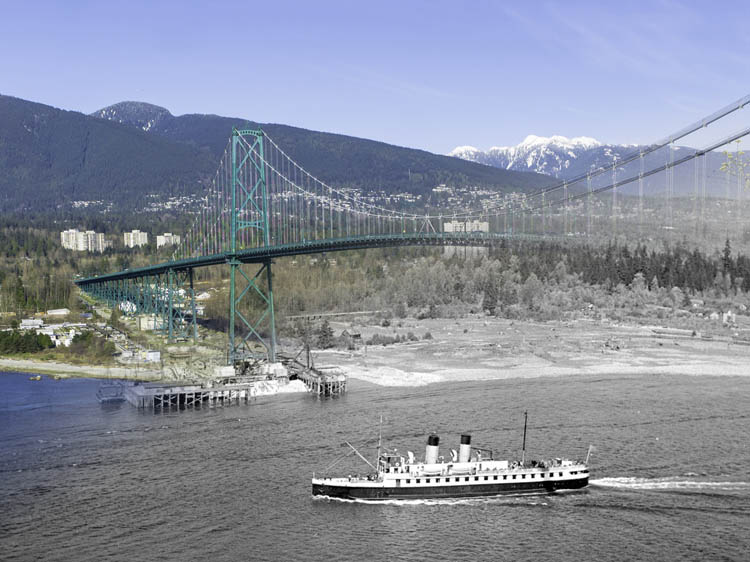Walking Tour
City of Duncan Totem Pole Tour
Two Families in One House

Discover Duncan’s world-renowned totem pole collection, an outdoor art gallery showcasing over 40 totem poles carved by Indigenous artists from the Cowichan Tribes and many other First Nations. This video tour guides you through downtown Duncan, where each pole tells a story of heritage, tradition, and living culture. At every stop, listen to Cowichan Tribes storyteller Chuck Seymour (Ts’ules) share the meaning behind these powerful carvings in exclusive videos and the remarkable stories of those who carved them. Hear ancestral narratives in his voice, learn the symbolism of figures like the eagle and salmon, and deepen your connection to this sacred art.
It’s a spectacular journey into the heart of the history, culture, and art of the Northwest Coast.
This project was developed by the Duncan-Cowichan Chamber of Commerce. Generous support was provided by the City of Duncan and Cowichan Tribes.
1. Centennial Pole
Chief Tlasutiwalis (Calvin Hunt)
We begin our journey at the spectacular Centennial Pole. This pole was carved in 2012 by the internationally renowned artist Calvin A. Hunt to commemorate the 100th anniversary of Duncan's incorporation as a town in 1912, making it the most recently carved pole on this tour.
* * *
Born the youngest son of Hereditary Chief Thomas Hunt, Calvin comes from an illustrious line of Kwagu'ł Chiefs and artists. The Kwagu'ł are a Kwakwaka'wakw people from the northeast coast of what we now call Vancouver Island, and the carving of totem poles has always been one of their most important traditions, one that has been adopted by Coast Salish peoples like the Cowichan Tribes in modern times.
"When I create these monumental sculptural pieces," Hunt explained, "I begin by envisioning who the pole is for, who or what it will stand for, and where it will stand. There are certain elements that represent the unifying symbolism of various animals and legends which I follow through the knowledge and teachings of my Gigame’ (Chiefs), Elders and artists."
Be sure to walk all around the Centennial Pole to take in the carvings on the back as well. Hunt explained their significance:
"The front of the pole is carved in traditional Kwakwaka'wakw style and the back is more Coast Salish. The snub-nosed canoe is representative of the Coast Salish style of canoe. The Quw'utsun' people are represented by the story of S-hwuhwa’us [thunderbird] and the Q'ul-lhanumutsun [killer whale]. The Chief Maker on the bottom of the pole is to honour the women in the community. The Salmon on the back are surrounded by painted lines representing the fish weir that is used to trap the Salmon. We wanted to honour the five original tribes in the ceremony [represented by the five salmon]; each tribe had a representative at the dedication. Everything was about blessing the day with the chosen dances and songs. Mervyn Child, my nephew, and family members assisted in carving this pole."
Over a 55 year career Hunt has been bringing Kwakwaka'wakw culture to the world. The masks, dance outfits, canoes—and of course totem poles—that he creates are globally renowned. He has many titles: Chief Tłasutiwalis of the Kwagu'ł, Fort Rupert Hereditary Chief Nas'am'yus, Mowachaht, Friendly Cove, member of the Royal Canadian Academy of Arts, and holder of the BC Aboriginal Achievement Award, to name a few.
Hunt's lifelong immersion in the values and traditions of his people is key to understanding his art.
As he explained: "becoming a skilled woodcarver means more than the artistic skill sets of carving; it is also about learning in the most holistic sense all aspects of Kwagu’ł culture, values, language, practices, song and dance. This work is fluid and informs everything that I create."
View this pole's entry on the City of Duncan's website.
2. Raven Stealing the Sun
Si-yaaxultun (Donald Smith)
The story told by this pole is perhaps the best-known story to all the peoples of the Northwest Coast, though it varies significantly and each tribe has its own version. It tells the story of how Spaal', the Raven, tried to steal the Sun, known as Sumshatut.
* * *
"The Raven on the top, the face in the middle represents the Sun, and the bottom figure is the Eagle, he is in a sitting position. His wings come out the side and he's holding the Sun, grasping it, taking it back from the Raven. The Raven is mischievous and stole the Sun. The Eagle represents the hero and he brings it back. In this particular version they are locked in… fighting over it… the Raven stealing the Sun and the Eagle returning it… the face in the middle of the chest on the Eagle… represents the Spirit, like an inner Spirit of the Eagle."
Looking at the pole you can see Smith's lively style and creative use of space. Take a look at the middle figure, the Sun. In Northwest Coast art, the Sun is best identified by the rays of sunlight it radiates outwards. The Kwakwa̱ka̱ʼwakw in particular loved depicting the Sun on totem poles, and they achieved the ray effect by adding wooden appendages filled with carved shapes and faces.
Smith instead achieved this effect by carving the rays on the sides and rear of the figure, enhancing a three-dimensional effect to the pole that rewards those who walk around it and view it from all sides.
It's sometimes been remarked upon that the medium carvers work in—round trunks of cedar—has shaped the direction of the art. It imposes some constraints, but the carvers' creative solutions have made totem poles a singularly unique and recognizable art form all around the world: The vertical stacking of figures; the forward-facing, usually crouched poses; the three-dimensional aspect that can be experienced from every angle.
When Donald Smith was asked why he chose the figures for this pole, he laughed: "It fit on the wood!"
View this pole's entry on the City of Duncan's website.
3. Bringing Light to the World
Kwátám-us (Richard Krentz)
This pole is by the Coast Salish artist Richard Krentz, who comes from the shíshálh Nation on what we now call the Sunshine Coast. His mother was an artist and his father was a canoe carver, and he has been carving since the age of five.
This pole, called Bringing Light to the World, was commissioned by Judy Hill, the owner of the Judy Hill Gallery, which specializes in Pacific Northwest Coast Indigenous art.
* * *
In the culture of the Northwest Coast the Master Carver played a far more expansive social role than a skilled craftsman in the Western tradition. In an oral society without writing, totem poles were but the grandest art form used to vividly illustrate the stories that people shared with one another. Dances, masks, songs, and smaller carved objects also filled the same role, and a Master Carver was often skilled in these crafts as well.
When a patron commissioned a totem pole it was to showcase his family's crests, notable episodes in his or his ancestor's lives, or stories of supernatural figures tied to his lineage. To bring these stories to life the patron would carefully select a Master Carver to hire. Before ever setting adze to cedar, the carver would spend weeks with the patron, living with their family, listening to their stories and history, and working to understand all the complex and minute nuances of the patron's experience and desire. Only then would the carver begin figuring out how to translate it all into carved form.
A young carver's apprenticeship under a Master Carver often lasted over a decade. A huge part of it was learning to interpret the culture and mythology of his people, the histories, crests, and ownership rights of the different tribes and families, and the complex rules and forms guiding the art.
Finally it was common practice for a patron to hire a Master Carver from outside their own tribe, meaning that Carvers became extremely well travelled.
It's easy to see why Master Carver's were necessarily incredibly gifted individuals—and it's no surprise that they held enormous standing and prestige.
They needed to be profoundly fluent in the culture of the Coast, intimately familiar with the traditions of its various peoples, and keenly aware of the political dynamics at play across the region. In some sense, a Master Carver was called upon to fulfill the roles of storyteller, historian, journalist, and diplomat.
This is all before we even get to the enormous technical and artistic skill required to turn a towering trunk of red cedar into the kind of stunning masterpiece that we continue to marvel at today.
View this pole's entry on the City of Duncan's website.
4. Wind Spirit
Doug LaFortune A.k.a. William Horne
This is the third pole we've seen by Doug LaFortune, and it is called Wind Spirit. At the top is the Thunderbird, and the smiling face gazing out from its chest is Suli 'U Tu Satuts, the Wind Spirit. At the bottom is Spe'uth, theblack Bear, who is clutching a halibut, or Stsa'tx, in its claws.
* * *
"I was doing a lot of hunting in the mountains and waters around Cowichan Valley and these are the things I like: Eagles, Bears, and Halibut. Like most Native people a long time ago, they were things that were in your life at the time. I like the power of the Thunderbird and wanted to show the powerful beak and claws. The Bear has to do with my son, his name is Bear. The Halibut is a creature that I really like and that I liked in oter totem poles. At this time in my career, I was emulating work that other artists had done and chose to do these figures as I thought I could do it and express my own feelings. You put a lot of feelings into these things because it takes three, four months of your life."
This was the first pole that Doug carved for the City of Duncan's totem pole project in 1986, and is one of which he is especially proud. It showcases a beautiful depth and level of detail all round, with the sunlight casting the figures in dynamic relief over the course of the day. Doug credits much of his inspiration for this pole to the more established and formalized Northern styles.
View this pole's entry on the City of Duncan's website.
5. Transition
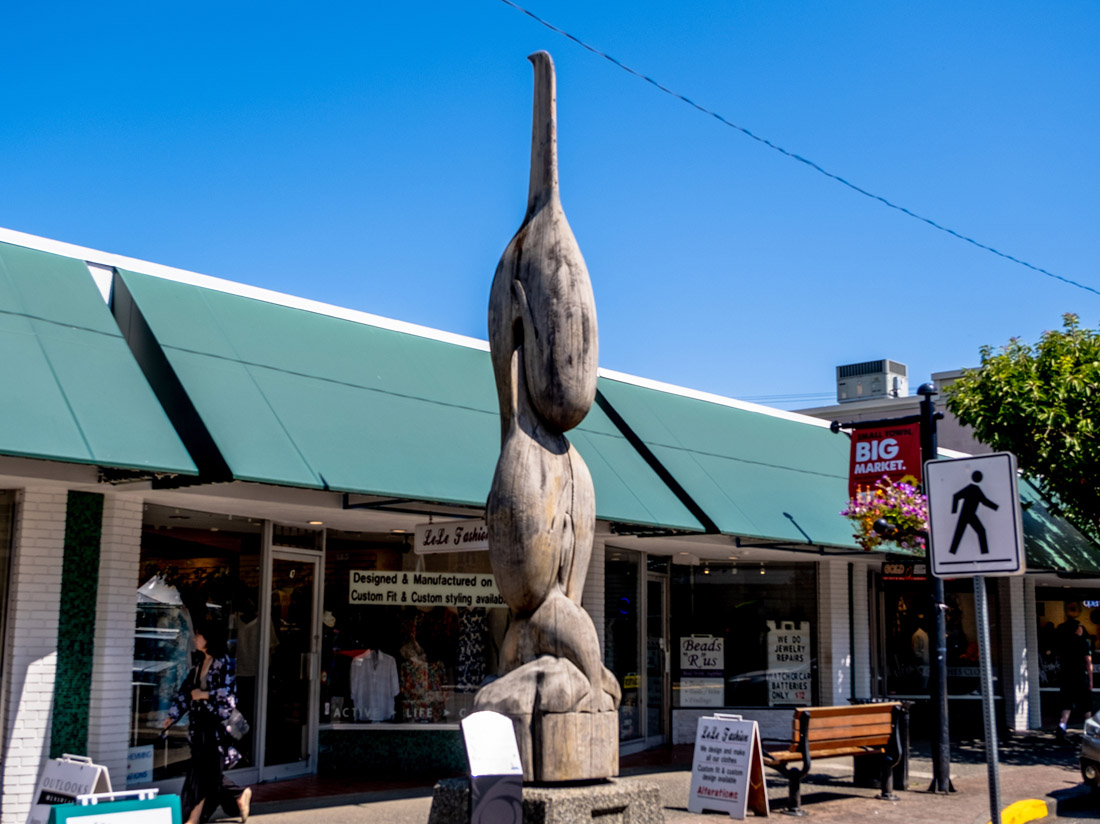
David Marston
"The story goes that the Quw'utsun' people were starving because the Killer Whale prevented the Salmon from coming up the Cowichan River. So the people prayed day after day, until finally their prayers were answered. The Tzinquaw (Thunderbird) came and picked up the Killer Whale, deposited it on Mount Tzouhalem; the Salmon started coming up the river again. In this case, the pole depicts the Thunderbird (mythical eagle figure) as a saviour and protector of our people; and the Killer Whale as a monster (Cowichan Tribes, Submission, 1986)."
"As a first process to carve a traditional pole you would burn the log, burn the outer layer with pitch. The result is a different colour on red cedar; it is sort of a grey-black. The black sea-going canoes were also prepared in this same manner. Today we would use the natural colours and not paint on the poles. (Harvey Alphonse, Interview, Nov 2012)."
* * *
View this pole's entry on the City of Duncan's website.
6. Thunderbird with Dzunuk'wa
Moopin-kim (Ned Matilpi)
Ned Matilpi, a Kwakwa̱ka̱ʼwakw artist from the Ma'amtagila Band on northeast Vancouver Island, carved this pole showing Thunderbird with Dzunuḵ̓wa. This is the one of several totem poles that depict the supernatural figure of Dzunuk'wa, the Wild Woman of the Forest. She occupies a feared and revered place in the culture of the Northwest Coast, and features in many stories.
* * *
The author Hilary Stewart writes that Dzunuḵ̓wa is always depicted with "pendulous breasts, heavy eyebrows, deep-set eye sockets with half-closed eyes—and pursed lips to indicate her cry of 'Ooh-ooh, ooh-ooh.' By character [she] is stupid, clumsy and sleepy—hence the slit or crescent eyes. She captures children who are crying or who venture into the forest, carrying them away in a basket on her back to devour them. The House of this awesome giantess is filled with wonderful treasures such as boxes of food, coppers, canoes and more. Through special encounters with her, a person could acquire some of this wealth and supernatural power."
View this pole's entry on the City of Duncan's website.
7. Human Between Bear Ears
Lenard Paquette Jackson
This pole, called Human Between Bear's Ears, was carved by Lenard Paquette Jackson, a Cree artist from Slave Lake, Alberta.
He described the pole, saying: "The human in between the Bear's ears is to make the Bear aware when Humans are around; the Human is also to watch out for the safety of the animals."
* * *
Maintaining totem poles, especially those exhibited outdoors, is an ongoing challenge. In the temperate rainforest climate of the Pacific Northwest, the paint will fade, the figures will become worn and cracked, and the base will rot. Eventually the totem pole will topple over and return to the earth.
The peoples of the Northwest Coast did what they could to extend their lifespan. There were many reasons red cedar was so favoured, but two were its high moisture resistance, and the great strength of its hardened sapwood.
Huge efforts were made to find red cedars that grew in deep, dark parts of the forest, where there was less temperature variation. This made them less knotty and more rot resistant.
Yet even the very finest red cedar poles would ultimately succumb to the elements after 50 or 60 years.
Some modern innovations have helped. When raised in the traditional manner a pole would be dropped into a hole in the ground that was filled in with rocks and gravel. The part of the trunk just above and below ground was by far the most susceptible to rot, and the place where most poles ultimately failed.
Nowadays poles like these in Duncan are secured to steel beams and raised just off the ground on concrete pedestals. To protect from moisture the City of Duncan has put metal caps on the tops to protect the vulnerable end grains. Coats of linseed oil, sealers, and fungicides can be applied as well.
All these steps can slow down the decay, but they cannot stop it entirely. That's why the City has a caretaker working constantly to keep Duncan's poles standing tall and proud, for the enjoyment of all.
View this pole's entry on the City of Duncan's website.
8. Clan Totem of Our Nations
Tommy Hunt Jr.
Tommy was born in 1964 in Victoria, BC, and given the native name of Watawidi. He is a member of the Kwagut, or Kwakwaka'wakw Nation. Tommy began apprenticing at the age of twelve with his father, Hereditary Chief George Hunt. Tommy has also learned under the guidance of Sam Henderson. Tommy's family is deeply involved in the potlatch system and many of his masks have been presented at these potlatches. Tommy has earned the title of master carver and apprentices younger artists.
View this pole's entry on the City of Duncan's website.
9. Harvest Time
KETÍWŦEL (Tom LaFortune)
Tom LaFortune comes from an illustrious family of Coast Salish carvers. He and his brothers Doug LaFortune and Dr. Francis Horne Sr., apprenticed under the hugely influential master carver Simon Charlie, and they too carved a number of poles featured on this tour.
* * *
"The North Wind, when it really starts to howl, that's when the Killer Whales would come in and feed in Cowichan Bay. When the North Wind got colder the Whales would head out to migrate, because the Salmon run was finished. The pole represents the harvesting time for the Salmon. With the North Wind, you notice the Killer Whales. You go down to the mouth of the river and jig for Salmon in the bay or wait for them to come up the river. That was the inspiration, a harvest time pole."
The large circular eyes, and use of red and black paint hint at the Northern influences on this pole. The human figure at the top representing the North Wind is called Satuts. His mouth is opened wide as if he is blowing a great gust of wind from his lungs. The Q'ul-lhanumutsun, or Killer Whale at the bottom, is depicted as if seen from above, which is often how whales are shown on totem poles. Its fluke is turned up and over its back, and carved into it is a face with a toothy grin.
View this pole's entry on the City of Duncan's website.
10. The Air and the Land
Yutxwam (Harold Joe)
The top two figures on the pole represent the Quw'utsun' legend of the Thunderbird and Killer Whale. Tzinquaw (Thunderbird) is one of the more rare and powerful beings in our (Quw'utsun') history. A Killer Whale is an extremely important part of our culture and history...The figure of Spe'uth (black bear) adds to the power of the story, as he is like the eldest of a generation; strong and protective (Tim Kuchylski, grandson, Interview, Feb 2013).
The wealth of the pole’s owner is indicated by the copper shield that spe'uth (black bear) is holding in his paws. Simon’s work is textured, which was his trademark; some of the animals would look like they had fur, feathers or scales. Another one of Simon’s trademarks was to put faces on the feet of the bear; a sad and happy a face. Simon would say that in life there are sad times and happy times.
* * *
View this pole's entry on the City of Duncan's website.
11. Owl Spirit
KETÍWŦEL (Tom LaFortune)
This is the Owl Spirit pole, the work of Master Carver Tom LaFortune. Born in Duncan in 1959 to the Tsawout First Nation of the W̱SÁNEĆ (Saanich) peoples, LaFortune began carving at age 11 under the mentorship of Simon Charlie, alongside his brothers, Doug and Francis. His Owl Spirit pole features an owl atop a Coast Salish chief. His mother was his inspiration:
* * *
The pole was LaFortune’s first solo large-scale work. Using chainsaws, chisels, and curved knives, he embraced the challenge of “full round” carving, insisting on developing his own unique style despite his brothers’ "older-brother syndrome."
LaFortune's work is distinctly Coast Salish:
"I don’t like to use a straight edge for everything, I like to use curved knives and just soften the look a little bit and still make it strong. That is the way I try and carve and that’s what I like to show is that me, as a Coast Salish artist it doesn’t have to be sharp and cut off, it can be soft and curved and finessed and flowing… you don’t have to colour all the wood just highlights here and there."
When LaFortune began carving, there was little interest in Coast Salish art. Over his career that has changed dramatically. LaFortune attributes it in no small part to wider political recognition of the Coast Salish as a nation:
"The Coast Salish are stepping up and they’re being noticed and now the artwork is coming right along with that…. Around the world, I’ve noticed that, I have been carving for 40 years, jeez, 42 years now. The more that the Coast Salish been recognized for where we live, the more interest there is in our life style and our art."
View this pole's entry on the City of Duncan's website.
12. Abolishment Pole
Si-yaaxultun (Donald Smith)
The Abolishment Pole is the first totem pole Don Smith carved for the City’s collection. Don is a Coast Salish artist from the Cowichan Valley, a member of the Cowichan Tribes. He began carving in 1985 and apprenticed under the respected Simon Charlie.
* * *
"The Bear represents strength. In this story, the Black Bear (SPE'UTH) is a Clan Member; the Frog (Wuxus) represents luck, wealth, and the end of the winter season. A youth had been terrorizing the tribe for quite some time. He never listened to his parents or the elders. A council was held to discuss the matter. A final chance was granted to the youth to turn things around for the better. This chance was ignored and it was then determined the youth be abolished from the tribe (this usually happened for very serious acts). The youth walked aimlessly until his demise. He was later discovered in a pond, his entire body covered with Frogs. The Frogs express the feelings shared in this story: sorrow, being content, and the demise of the youth."
Don carved this pole in 1990 at the Quw'utsun' Cultural & Conference Centre. His Coast Salish style incorporates intricate, three-dimensional elements that push beyond traditional forms. While Coast Salish art is often described as bold and simple, Don refines it with greater depth and detail.
Using both traditional and modern tools, he shapes his work with chainsaws before refining it with specialized hand tools. It is an embrace of the evolving nature of Coast Salish art, balancing heritage with innovation.
The Abolishment Pole delivers a timeless lesson on respect, community, and the consequences of one’s actions, reminding us to listen, learn, and honor ancestral traditions.
View this pole's entry on the City of Duncan's website.
13. Sea and Sky
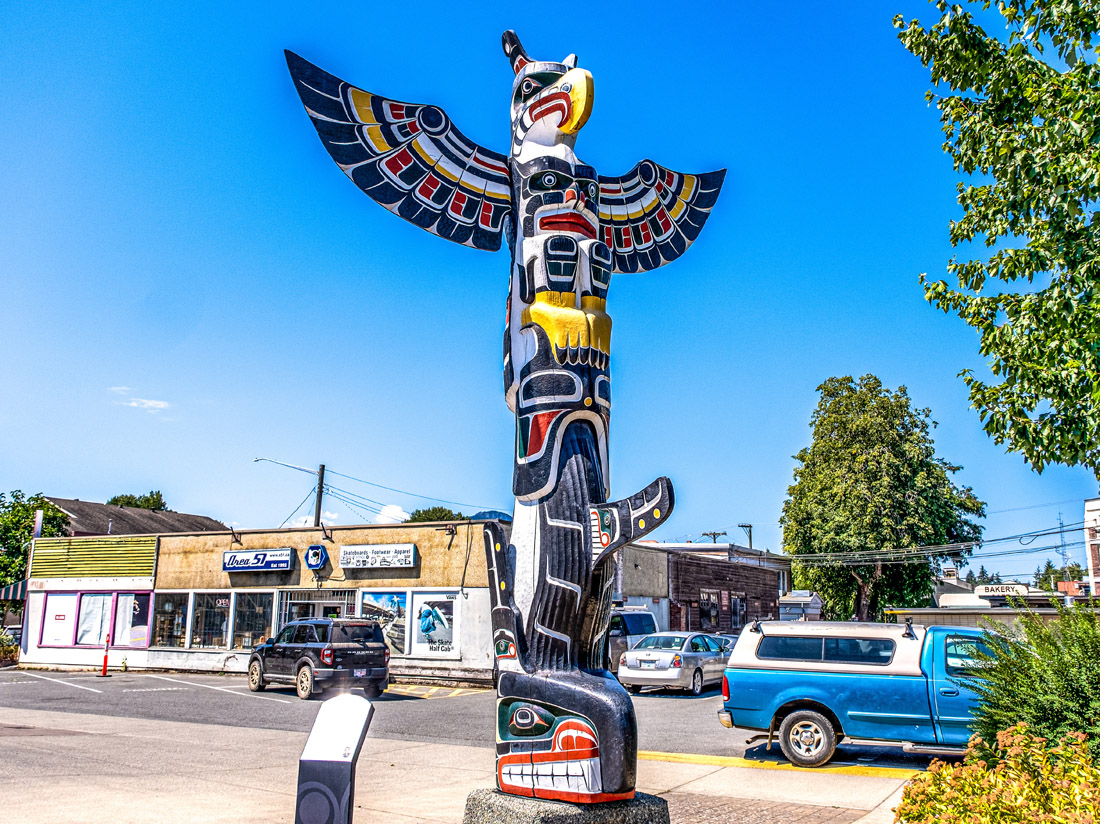
Harold Alfred
"This pole depicts the story of a transformation in life. The bottom figure signifies a Man on a vision quest. During this rite, an Eagle carries him away. When he returns as a young person, the Eagle with the wings wrapped around him represents his Guardian Spirit. His life starts, like a rebirth or as some people state a second chance to change his ways. The Eagle represents wisdom, great vision, and healing (Harvey Alphonse, Interview, Nov 2012)."
Harvey was influenced by local carvers, including Nelson Canute who worked with Harvey on this pole. Nelson carved the top figure of Eagle holding the young person.
* * *
View this pole's entry on the City of Duncan's website.
14. Eagle, Raven, Bear
Lenard Paquette Jackson
This pole is called Bald Eagle, Raven, Black Bear. It was carved by the Cree artist Lenard Paquette Jackson, who was born in Slave Lake, Alberta, and brought his artistic talent to Duncan, honing his craft for almost 30 years.
Len's mother was murdered when he was just two years old, a tragedy that haunted him and also drove him to create great works of art. Speaking about one of his works, he said: "I want to honour my mother who was murdered when I was two and a half years old and other women from around the world who have been murdered, terrorized, and beaten. It's time for us to stop that. Women should be treated with kindness and respect. They are the life givers."
* * *
He said of this pole:
"The Eagle symbolizes knowledge, eyesight, and carries messages to the creator. The Eagle is a prominent figure. The Human below the Eagle’s feet, in between the Raven’s ears, is to show that without the Human, art would not be accomplished. The Raven brought light to the world; he is also a shape shifter (similar to the prairie coyote stories of the Cree). The Bear is the King of the Forest, a very important “person” in the forest. Humans need to watch out for the Bear. The Human in between the Bear’s ears is to make the Bear aware when Humans are around; the Human is also to watch out for the safety of the animals."
The eagle at the top is best identified by its curved beak, while the raven beneath it has a straight one. The bear is in a typical crouched pose, with sharp incisors, long claws, and small ears.
This pole has many characteristics of the northern styles of the Haida and Tsimshian, like the sparing use of red and black paint, and the large round eyes. The small human faces peering out from between the ears of the raven and the bear also hint at Haida influence. The Haida were ingenious artists and had a great love of dynamic interlocking figures, as well as smaller carved figures and faces to fill out the spaces between the main figures.
Len faced many challenges in life, but he stayed strong and resilient throughout. He lived by his often repeated mantra "focus on today. Yesterday is history. Tomorrow's a mystery. Today is a gift, that's why we call it the present."
View this pole's entry on the City of Duncan's website.
15. The Gwa'yasdams Flood Story
Haeklas (Basil James)
This pole depicts the flood story of the island of Gwa'yasdams, which today also goes by the name Gilbert Island. The island is between the mainland and northern Vancouver Island, and is where the carver, Basil James, came from.
* * *
"Kwankwanxwalige (Thunderbird) is on top of the pole. He came down from Mount Stephens, right after the flood. There was a little village there, we call it K'we. He took his Thunderbird dress off and he acted like a man. On the chest of this Thunderbird is a giant, a Dzunuk'wa (Wild Woman). On the bottom of the pole is the Max'inuxw (Killer Whale) and on his fin is the Luwagila (Raven). The Killer Whales… They save a lot of men and take them ashore."
This story has been passed down since time immemorial by James's family, and belongs to his lineage. As Jack explained in the interview "they are all ours, our own. We didn't copy anybody's."
A great flood in the ancient past is remembered by people up and down the coast, including the Quw'utsun'.
The Quw'utsun' story is retold in Those Who Fell From the Sky: A History of the Cowichan Peoples, by Daniel P. Marshall.
The Quw'utsun' remember the first man as Syalutsa, who fell from the sky. One day he heard an inner voice telling him to construct the largest canoe ever seen, and to weave a cedar rope of incredible length. When he was done, the voice told him to tie one end of the rope to his canoe, and the other to the peak of Swuqus, which is now sometimes called Mount Prevost and can be seen from Duncan when you turn to the northwest.
Then it began to rain. It rained and rained, so that the Cowichan Valley flooded, and Syalutsa's great canoe was lifted higher and higher. The waters rose above the peak of Swuqus, and continued to rise and rise, until finally the enormous rope anchoring the canoe finally went taught. When that happened, suddenly the rain stopped, the sun came out, and the waters receded. Syalutsa and the Quw'utsun' people had survived.
View this pole's entry on the City of Duncan's website.
16. Peaceful Boundaries
Norman John
Peaceful Boundaries is a totem pole by Norman John. John is from the West Coast of Vancouver Island, land of the Nuu-chah-nulth (or sometimes called the Nootka).
It tells a tale from the Wars of the West Coast Peoples in the distant past, one that was passed down to John through many generations.
* * *
“At one time on the West Coast of Vancouver Island, the [Nuu-Chah-Nulth]... were fighting and killing one another over fishing and hunting grounds. This went on for years. The elders became deeply concerned over the loss of our people and got together with the chief to stop this needless killing. The Chief got all of his carvers together to carve Sea Serpent, Wolf, and Macquinna masks-feast bowls. Then he sent a messenger to all tribes for all the people to gather together. He spoke to stop all the fighting and killing. One of the younger men spoke up "it is either kill or be killed". Again the Chief spoke and started negotiations governing boundaries. So it came to pass that all boundaries were marked and honoured by all tribes. These masks are still used today to dance and celebrate marriages, naming of children, memorial potlatch (1 year after a death.) My Dad enjoyed carving the Raven and this was often reflected In his work over the years. I also felt Inspired to carve the Raven for the top of this Totem.”
Traditionally the Nuu-chah-nulth did not have a family crest system, unlike the peoples of the north. This is perhaps part of the reason why the Nuu-chah-nulth did not carve the monumental heraldic poles of the north, which showcased a chief's family crests. Instead, the Nuu-chah-nulth did elaborately carve their house posts, and erected welcome poles on beaches. They also became renowned for the craftsmanship of their ritual and ceremonial objects, like feast-bowls and spoons. And of course in the monumental 40 foot canoes they used for the wildly audacious and dangerous whale hunts, for which their people became legendary.
View this pole's entry on the City of Duncan's website.
17. Cedar Man Walking out of the Log
Gwe-la-y-gwe-la-gya-les (Richard Hunt)
This monumental totem pole, Cedar Man Walking Out of the Log, was carved from a 775-year-old red cedar that once grew near Port Renfrew.
* * *
It is the work of Kwaguʼł Master Carver Richard Hunt. Hunt explained how he came to carve Cedar Man.
"I was really excited at the chance to work on something so huge and I thought about how I could use theog to its fullest width. I decided to carve Cedar Man, the spirit of the cedar tree personified. For inspiration, I used the Cedar Man figure on Mungo Martin's memorial pole in Alert Bay, that my father carved."
In 1988 the log was donated by the MacMillan Bloedel Company and Hunt began carving—right here, on site. The process became a public spectacle. Bleachers were set up and people visited day-after-day to watch Hunt work. He used jumbo-sized tools fit to the task: shipwright’s adzes, double-bit axes, and chisels with blades 3.5 inches wide, almost double the size of the largest chisels in most carver's toolkits. Soon a figure began to emerge: a 6-foot-tall head with 16-inch eyes, holding a talking stick over 4 metres tall.
"The top of the log was left natural so people could see the size of the log and it forms the hairline for the Cedar Man. On the chest there is a copper, which represents the wealth of Kwaguʼł families. The skirt represents the traditionally worn cedar-bark skirt. On the talking stick, the representations are all family crests: the top is the Kulus (Baby Thunderbird) which represents Richard dancing the tamed Hamatsa; the Killer Whale in the middle represents the spirits of our great chiefs; and the man on the bottom represents a Kwaguʼł family member."
A totem pole this massive could not be raised in the normal fashion, and a crane had to be brought for the occasion. When the pole was officially dedicated members of the Hunt family attended in full regalia, performing their traditional dances to a huge crowd.
From ceremonial skirts to masks used in dances like the Hamatsa—where young initiates shed wildness through a sacred cedar-clad dance—the cedar tree binds the Kwakwa̱ka̱ʼwakw to their land and legends.
“From afar, Cedar Man stares down at you, alive, stepping from the log.”
Here, the world’s widest totem pole immortalizes not just a mythic narrative, but the enduring dialogue between the first peoples and red cedar; a monumental testament to the resilience of their traditions and the supreme creativity of their art.
View this pole's entry on the City of Duncan's website.
18. Cedar Woman and Man
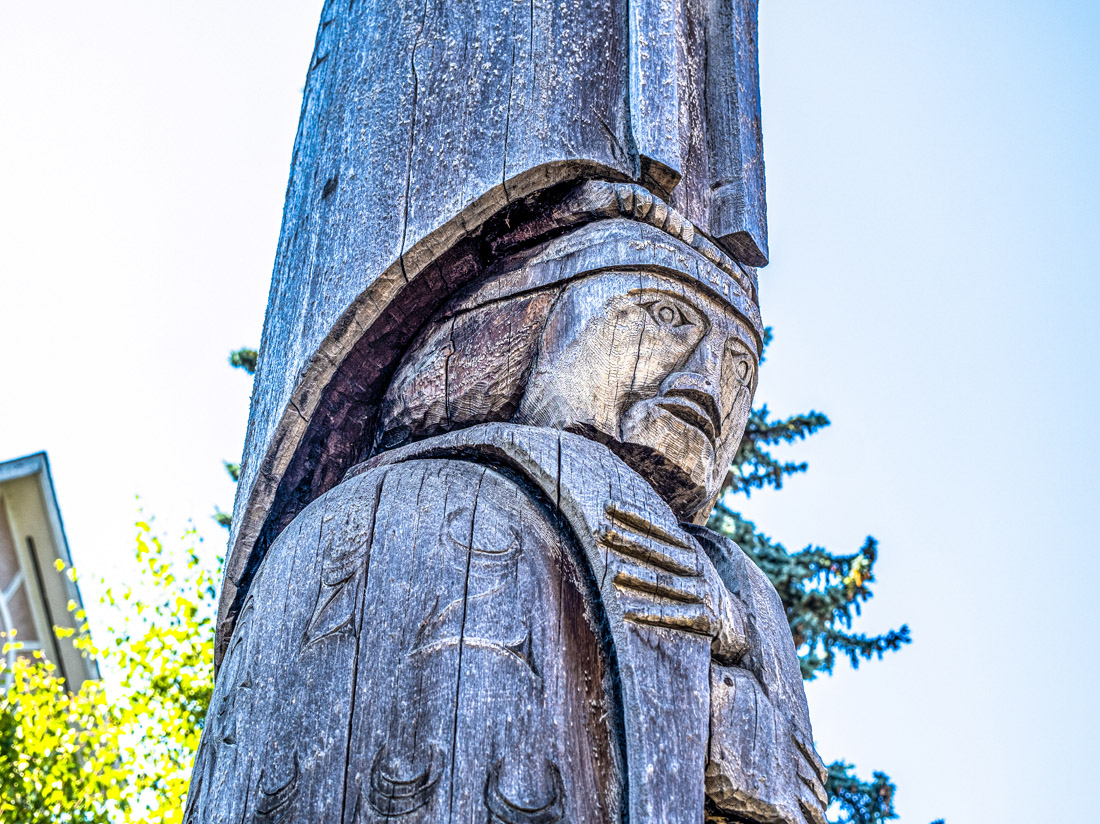
Hwunu'metse' (Simon Charlie)
Harold shared his family’s story about traditional carving: This is what my grandfather told me before I started….everything is always about the balance…traditional, right from the start. It is well-known in First Nations culture that there is always a balance in life.
Harold feels most comfortable using the raven and the beaver figures, which are his family clans.
"The symbolism is the air and the land, we have to learn to balance that. Both are Mother Earth’s cleaners…to keep Mother Earth clean. That’s why I chose to do that. It’s the symbolism, the green around the eyes. It’s what the animals see, Mother Earth, on the trees and mountains, it’s green. The pole is also about motivation. The Raven draws people to it and the Beaver represents an educator for the young, the builders (Harold Joe, Interview, Oct 2012)."
* * *
View this pole's entry on the City of Duncan's website.
19. Pole of Wealth
Norman John
This is the Pole of Wealth, by the Nuu-chah-nulth carver Norman John.
* * *
The acquisition of wealth was important because it represented the best insurance against adversity and intimidation by others. Showcasing wealth drew prestige and honour to its holder. Society revolved around potlatches, where the host demonstrated his wealth by ostentatiously giving it away to the attendees—sometimes at a ruinous cost to the host.
Trading sea otter pelts with Europeans in the 1800s provided a massive new source of wealth to the peoples of the Northwest Coast. Totem poles, which were extremely expensive to commission and erect, were a powerful way to show that newfound wealth off. The practice of totem pole carving quickly spread up the Skeena River and down the coast, though it was particularly popular with the Haida. This artistic boom peaked in the mid-1860s, before waves of infectious disease brought by uninvited settlers decimated the First Nations population.
The banning of potlatches in 1884 further crippled the spreading of wealth. Precious items like feast bowls, ladles, masks, headdresses and, dance/ ceremonial regalia could no longer be exchanged. Even worse, the kidnapping of children to residential schools meant families could no longer pass down their stories that had endured since time imemorial. Carvers died without transmitting their knowledge.
Wealth, in this sense, is also generated by sharing ideas and stories and this is why the City of Totems is so important today.
Jane Marston who assisted Norman with this pole remembers:
“All these artists used to “hang out” together in Duncan during this time and shared ideas, usually at Simon Charlie’s carving shed. This pole was a style that Simon started; it is a pole of wealth. The Thunderbird and Killer Whale are strong symbols with many First Nations on the Northwest Coast. The Bear is a Black Bear as they are from Vancouver Island. Norman had his own style of carving that two of his nephews were starting to emulate (in the 1990s). No one else is using this unique style, It is not considered Coast Salish, Nuu-chah-nulth or Kwagui‘i; it was uniquely his own.”
View this pole's entry on the City of Duncan's website.
20. Transformation of Man
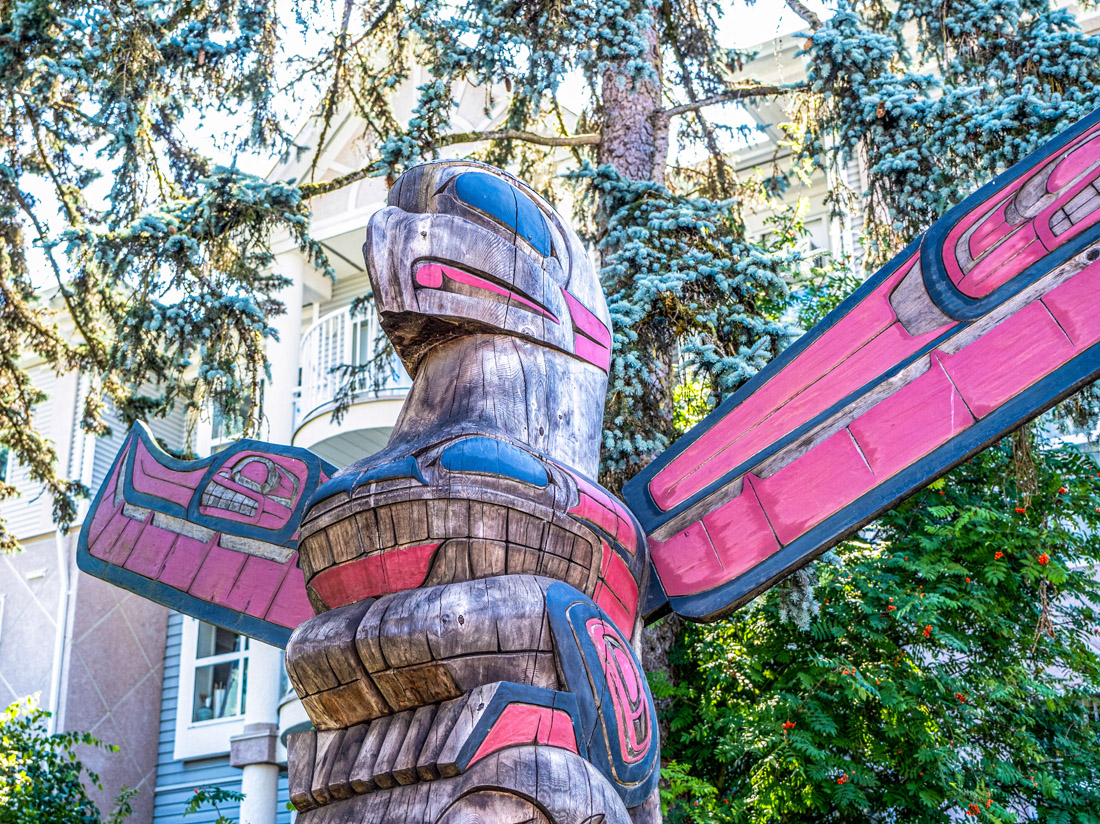
Glen Edwards, Andrew Edwards, Herb Rice
"The pole was done more as a symbol of British Columbia, as the figures represent sky and sea, and were done in a balanced relation to one another. The powerful Thunderbird being a symbol of the supernatural and of strength, with lightning and thunder as signs of his flight. The Killer Whale is shown in its awesome form reflecting its natural presence (Harold Alfred, Submission, 1990)."
The Thunderbird is a mythical creature that is common in First Nations stories on the Northwest Coast, and the Killer Whale is often shown on poles with the Thunderbird. The colours that Harold used to paint this pole were inspired by commercial products: an Export “A”® cigarette package for the green and a Coca Cola® pop can for the red.
John Ingraham, who taught the art of carving in the Kwakwaka’wakw territory, assisted Harold with carving this pole.
* * *
View this pole's entry on the City of Duncan's website.
21. The Guardians
Khut Whee Mul Uhk (Dr. Francis Horne Sr.)
The Guardians was carved by Dr. Francis Horne Sr., one of five poles he has created for Duncan. Though he is a Coast Salish artist, with a Tsawout, or Saanich mother and Lummi father, this pole is done in the Northern style and the guardians at the top are traditionally associated with the Haida.
* * *
"The three watchmen on the top of the pole are guardians against evil over the Xwélmexw (First Nations peoples). The Eagle, Yuxwule’, symbolizes freedom of spirit. Below the Eagle's feet are its tail feathers."
The watchmen, or Shelemuxutun, scan the horizon with eyes peeled for danger, like the approach of war canoes. Notice the four cylinders on their hats: These cylinders, called skils, indicate the enormous prestige of the chief they are guarding. The number of skils might be part of the family crest, or tell us how many potlatches the chief had held.
The need for watchmen was not just symbolic. Amongst the peoples of the Northwest Coast the Haida developed a ferocious reputation for their skill at warfare. Haida war parties set out in massive cedar canoes crewed by up to sixty armed and armoured warriors. They ranged up and down the Northwest Coast staging lightning raids to seize coppers, Chilkat blankets, and captives.
Haida raids struck such fear into the Tsimshian of the Skeena River that they developed a sophisticated signal-fire alert system to warn all their villages of the approach of a Haida war party.
The construction of many fortresses on Haida Gwaii show that they weren't immune to raids either. In the 1770s Captain Cook was so impressed by a fort he saw on an island in Haida Gwaii, that he called it Hippa Island, after the Maori forts he had seen in New Zealand.
These huge palisaded earthworks included clever defenses, like heavy pits covered by trapdoors, raised platforms stored with boulders for flinging down at attackers, and huge logs that could be released and rolled down onto an enemy.
View this pole's entry on the City of Duncan's website.
22. Dzunuk'wa
Hokwawadi (Oscar Matilpi)
This depiction of Dzunuk'wa, the Wild Woman of the Forest, was carved by the Kwakwa̱ka̱ʼwakw artist Oscar Matilpi in 1989. He was the father of Ned Matilpi, who carved his own interpretation of the Wild Woman for the City of Duncan. Oscar, who was born in 1933, passed away in 1999.
* * *
"Those who are fortunate enough to have Dzunuk’wa in their possession are watched over and protected. Black in colour, with bushy, unkempt hair, she is usually shown with a pursed mouth. In the absence of the owner, Dzunuk’wa acts as an official greeter to any caller, ensuring that no visitor will go away offended by not being properly welcomed. Should a visitor remove, harm or damage any property in the absence of the owner, Dzunuk’wa sees to it that the perpetrator is punished by various means. She may cause strong winds to blow from her pursed lips, which would result in their canoe sinking on their way home with their ill-gotten goods."
"The copper shield depicted on this pole is a visual and philosophical gesture that shows the person that lives there is powerful and actively holds pe’sa (potlatches)."
Oscar learned to carve at a pivotal time and place in history.
The art of totem poles was almost lost forever during the catastrophic upheaval of the late 1800s and early 1900s. By the 1930s only one or two master carvers remained in all British Columbia that were able to pass on their precious knowledge to the next generation. In the 1950s the Provincial Museum of BC inaugurated a huge totem pole carving project at Thunderbird Park in Victoria, and hired one of those last carvers, Mungo Martin, to train new apprentices. Mungo, then in his 70s, set himself to the task with incredible energy and vigour, and took on a whole new generation of apprentices.
By the time Mungo passed away in 1962, his tireless efforts over the last decade of his life had borne fruit. He didn't just help bring the art of the Northwest Coast back from the brink of extinction, but had sparked a remarkable artistic renaissance that continues to this day.
Oscar was part of that crucial bridge generation between Mungo and the carvers of today. He first took up carving at the age of 37 and joined the project at Thunderbird Park, where he worked alongside many of Mungo's most talented apprentices, including his brother-in-law Henry Hunt. Later he was able to pass this knowledge on to his son Ned.
View this pole's entry on the City of Duncan's website.
23. Chief's Pole
Khut Whee Mul Uhk (Dr. Francis Horne Sr.)
Heavily influenced by Simon Charlie and Doug La Fortune, Dr. Francis Horne Sr. created the Chief’s Pole to tell the story of how humans and the Q’ul-lhanumutsun killer whale, came to live in harmony.
* * *
“On the top of the pole is a Human Child. The Killer Whale represents the Quw'utsun' story of the Killer Whale that was in Cowichan Bay eating all the Salmon. The pole story shows how the Quw'utsun' people were able to restore peace back to the people, and that the people and the Killer Whale can live together in peace. The Child is kneeling, waiting with anticipation for the Salmon. The Copper held by the Chief, is to show wealth in the Human Spirit, not material wealth. Simon Charlie taught us to let the wood guide the hands for what was to “come out of” the pole.”
Horne is of Coast Salish heritage and was born in 1954 in Mount Vernon, Washington. His mother is Tsawout, or Saanich, and his father is Lummi, from Washington. Horne was raised on Vancouver Island and taught himself to carve at the age of eighteen. Horne is the second oldest of six brothers, all of whom are accomplished artists and two of whom carved poles for the City of Duncan—Doug and Tom LaFortune. As a world-renowned Master Carver, Dr. Horne has shared his knowledge of carving with hundreds of people.
View this pole's entry on the City of Duncan's website.
24. The Family
Khut Whee Mul Uhk (Dr. Francis Horne Sr.)
Family is of utmost importance for the peoples of the Northwest Coast and this is no exception for Dr. Francis Horne Sr. He is from a large family with many siblings so Francis’ understanding of the role that family plays in building a community informed his creation of The Family totem pole.
* * *
“The pole represents family; it could be anyone’s but in this case it is the Painter’s. The Painter’s owned Duncan Electronics and were a family business. I wanted the pole to represent them as a family, not just business owners. The top figure is an Eagle, which represents the Eagle clan; the Eagle is holding a baby Eagle. The father is holding his son”.
Everything in Coast Salish society is built around the family. Traditionally siblings, cousins, and in-laws would form extended families, living together in great cedar-plank houses and claiming rights to resources and inherited privileges. One or more extended families would make up a village or community. That community was linked through ties of marriage and kinship with other communities, and those communities were in turn connected to other communities. And so on and so on, making up a vast family-based social network with no easily definable boundaries.
The family didn't just ground people in human society, but helped ground them in the natural and spirit worlds. Every Salish family has a creation story and relationships with spirits or beings that have helped them grow and survive. They understood the interconnectedness of all things, and understood the ways they dependent on their environment to survive. Thus to the Coast Salish every life form has a spirit, and showing respect to these spirits would ensure a family’s resilience and continued abundance.
View this pole's entry on the City of Duncan's website.
25. ‘thu-itsthuw tun shqwaluwun’
Charlene Johnny
The Quw’utsun Mustimuw have historically lived in the Quw’utsun valley and had summer villages along the Fraser River on the mainland pre-colonization. Since time immemorial we have lived in harmony with and taken care of land and mother earth. The designs that are depicted in this mural are a reflection of snuw’uy’ulh (teachings) from our siem s-ul’hween (respected elders).
The theme of this mural is reconciliation. Elder Albie Charlie stated that sharing Cowichan history is an act of reconciliation because we cannot build better relationships without a better understanding of Cowichan culture and values. This mural contains elements of our culture and values that have developed throughout our history in Cowichan. Additionally, the tears of the sun and the orange footprints represent the grief and sense of loss that we feel for the children who did not make it home from residential schools.
* * *
It is also important to illustrate our relationship with mother earth, and one of the most important gifts she gives us is cedar trees, the tree of life. Four is a sacred number, so it is important for us to showcase cedar trees. From these we were able to weave baskets and regalia, carve canoes, construct longhouses, and much more. There was a story shared with the mural committee by one of our Elders. It was about how our people gathered together to log trees to make a longhouse. This element shows how we pulled together accomplish a goal and also showcases our history of logging the Cowichan Valley. We also have some people paddling in a canoe, this is to showcase how we used to use the waterways as our highways, pulling together.
Another important element of the mural is the thunderbird and the orca up at the top right-hand corner of the mural. Many people know the history of the Quw’utsun Valley, and it is how the thunderbird saved the Mustimuhw from starvation, scooping up and taking away the orca that posted up at the mouth of the river and was eating up all the salmon.
Another prominent element of this mural is the solar eclipse at the top, balanced between two hummingbirds and the thunderbird and orca. The Quw’utsun Valley is known as the warm land and we are known as the warm people. The solar eclipse is recognized as a powerful time of transition, and the sun is the giver of life. I have incorporated a male and a female hummingbird, to represent a story shared by Elder Albie Charlie, but also to showcase the balance that is required in life.
The final element is the background of the mural. I have incorporated geometric patterns in the background in two toned colours of the sky. In a way, this showcases our connection with other cultures, as Quw’utsun Mustimuw were not the only tribe to incorporate geometric patterns into our weavings. Many other indigenous people and other nations across the globe use geometric weaving patterns. I think it is important for us to remember what we have in common with each other rather than our cultural differences. What is key in our future moving together into the future, is to care for mother earth. So even though this element is meant to be subtle, it ties in the theme of the past, the present and the future and the teaching of Nanum’Iyus Tth’ele, a meeting of happy hearts.
26. Family Pole
Doug LaFortune A.k.a. William Horne
Here we see a fierce mother bear, Ten' U thu spe'uth, protectively cradling her cub, Spe'uthal'lh. This is the fourth pole by Doug LaFortune on this tour, and he named it the Family Pole.
* * *
He was inspired by the Kwaguʼł carver Henry Hunt, after seeing a bear pole he had done for the ferry terminal at Port Hardy.
Though Doug is Coast Salish, he carved this pole in a more general Northern style, using only the traditional black and red, and giving the figures large round eyes. The bear is immediately distinguishable by its sharp teeth and claws, certainly a mother bear one would not want to disturb.
View this pole's entry on the City of Duncan's website.
27. The Tzinquaw Story
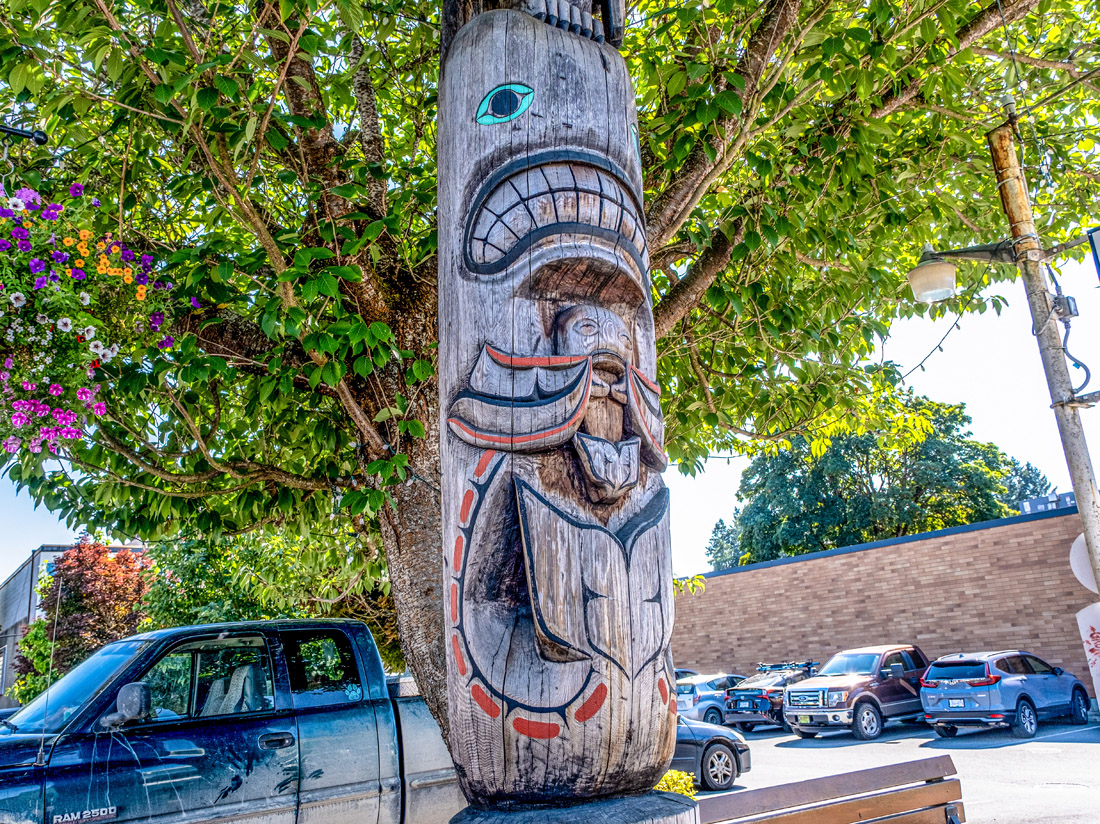
Chief Swaletthul't'hw (Harvey Alphonse) and Kelly Antoine
This pole tells the story of Canada’s hero Rick Hansen.
"Corky wanted to honour the work that Rick was doing. Corky had an accident and could relate to the difficulties people had with mobility. The idea of the pole was to tell the story of Rick’s journey around the world (Marilyn Baines, wife, Interview, Sep 2012)."
"The Eagle is a representation of the Great Spirit. The Eagle soars really high and it can see a huge distance…Corky was thinking of how Rick Hansen looks out and sees beyond. The Killer Whale is a symbol of transformation; on the whale fluke is a carved face, and that represents the Wolf. The Killer Whale will come up onto the land and it will change into the Wolf and hunt on the land as a Wolf. Rick transformed himself and made a huge difference in the world (Jane Baines Marston, sister, Interview, Nov 2012)."
* * *
View this pole's entry on the City of Duncan's website.
28. Sq’uq’iptul’ (Journey Together)
Stuart Pagaduan
This image tells the story of our Quw'utsun people who paddled the ancient highways. Large cedar canoes would be used to travel up and down the coast. All living things were respected and valued. None more than the cedar tree. It is also known as the tree of life because of its multiple uses and more importantly its spiritual value. The canoe is respected as a living being and not just an object. We need to be in a good place before we touch it or get in it. We take care of the canoe like you would a child, or yourself.
* * *
The humans represent unity and understanding. The elders of yesterday and today will always encourage you to help one another. The number of paddlers is four, a sacred number to the Quw’utsun people that is reflected in the balance of nature and seasons. Work together as one and continue to respect all living things great and small. No one is more or less than, we all work together and have different gifts to share.
The elements were chosen to keep the image simple and let it be as large as possible. Raspberry pink colour was chosen to bring brightness to the artwork and as a modern tone.
29. Poupou Tane Hiira, Pou Karanga

Tupari TeWhata
"In Kwakwaka'wakw culture, woman "tsadak" are the life givers, chief makers and the carriers of our cultural property. In many of the most sacred Kwakwaka'wakw ceremonies, it is only the woman that can perform and fulfill the spiritual roles that are able to complete such traditions. It is always said in the traditional gatherings that the children “gingananam” are the "reason" that the Nation continues to carry on with their traditions and cultural ways.
"The Bear, "Gila" to our Kwakwaka'wakw People, symbolizes the power and authority that our noble ancestors and Chiefs carry throughout our territories. As a reminder to our people about the great teachings that were shared through this union, we carve the bear on our house posts to remind us of our responsibilities to our guests when we invite them into our houses. We are to protect and guard all who have honoured us by responding to our invitation and must ensure that they are treated with respect and honour while in our house.
"The salmon "kutala” is our greatest resource on our BC coast. It is the salmon that has allowed numerous nations to survive with abundance and wealth. Among our Kwakwaka'wakw Nations, we believe that when twins are born, they are a gift from the Salmon People. Twins are entitled to perform the Salmon Dance and usually a composer will create a new song specifically for that set of twins to dance and celebrate the special gift of twins."
* * *
View this pole's entry on the City of Duncan's website.
30. Mortuary Pole
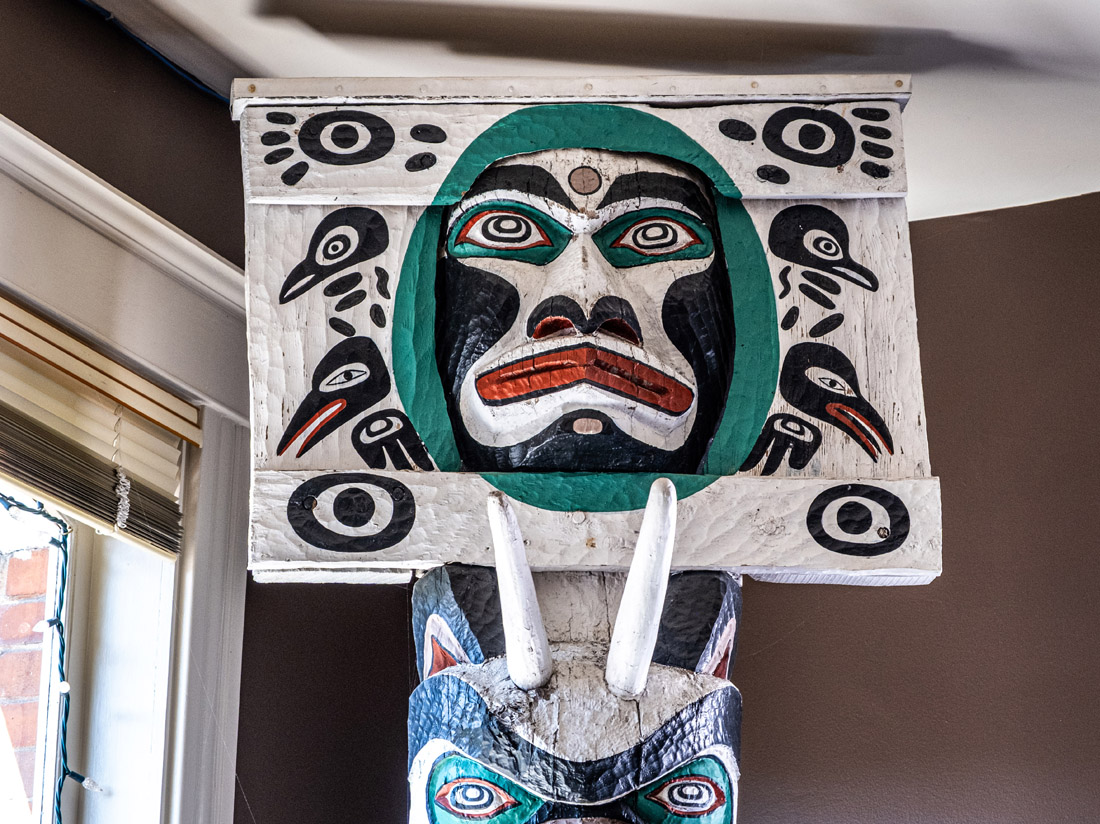
Hwunu'metse' (Simon Charlie)
"David explained that the pole represents personal growth and transition. The pole represents the family: the mother, the father, and the child. The Seal represents the family’s food supply. We share the earth with the Killer Whale and Seal, and they share it with us; we affect each other. The Seal, Killer Whale, and Man share the wealth of the sea, namely Salmon (David Marston, Interview, Oct 2012). "
David’s nephew Peter Francis worked with him during the three months it took to carve the pole. In cutting between the top and middle whale they used great care to not overcut and lose the integrity of the shape of the pole.
In describing the whales on the pole, David said: the Killer Whale is the helper spirit of fishermen. His inspiration for the pole was from his friends and his wife, Jane Marston.
* * *
View this pole's entry on the City of Duncan's website.
32. Woman of the Dunes
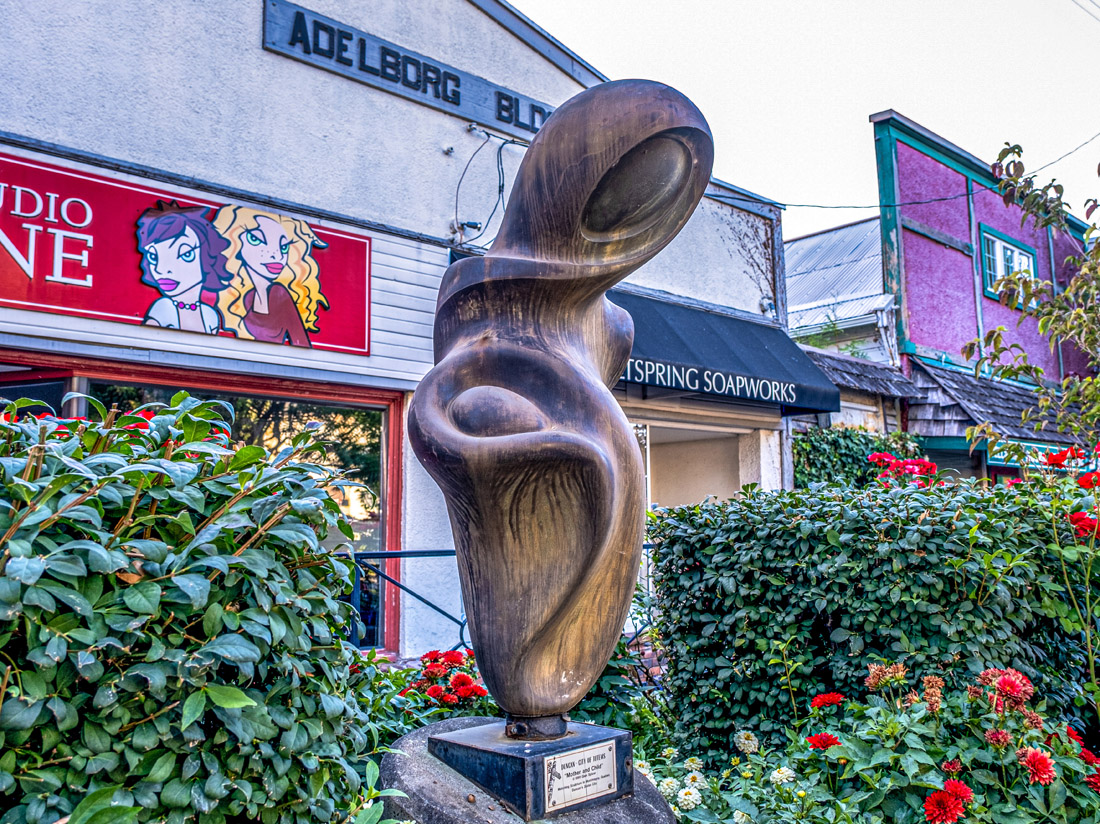
Claude Tardif
Similar to Duncan's totem project, Duncan's sister-city, Montmagny, in the province of Quebec, created public space to encourage sculpting. Claude was invited to Duncan as part of the sister-city program to produce this sculpture.
"My "La fille des dunes” (woman of the dunes) is a woman who is on the edge of the water, on a rock, who scans the horizon to see if her husband's fishing boat will return soon. In earlier times, wives of fishermen were worried about their partners who went fishing during storms and were slow to return to port. They would go to the shore to calm their fears. In memory of that era and to pay tribute to those women I created this artwork (Claude Tardif, Interview, Dec 2012)."
It was a challenge for Claude for two reasons: to carve a piece of this size and to speak to people in English. He stated he really enjoyed his time with the other carvers.
* * *
33. Eagle Pole
Khut Whee Mul Uhk (Dr. Francis Horne Sr.)
The Eagle's Pole shows both Yuxwule’ (Bald Eagle) and Squl’ew’ (Beaver). This was the very first pole carved for Duncan's City of Totems, and Dr. Francis Horne Sr. included the industrious beaver to symbolize the start of this huge project.
* * *
“The Eagle for the Horne family represents freedom of spirit. The face on the chest represents the spirit of the Eagle. The Beaver was chosen as it represents the builder. The Chief’s face on the Beaver tail represents the people of the community, the Quw'utsun’ people.” (Francis Horne Sr., Interview, Jan 2013).
In 1985 Mayor Douglas Barker decided these poles would put Duncan on the map by beautifying the community and marking the close ties between Duncan and the Cowichan people. They would distinguish Duncan "as a community that recognizes and appreciates the unique art form of the totem pole and all it represents."
The project was seized upon with enthusiasm and Duncan rebranded itself "The City of Totems." It was not without reason: It now boasts the largest outdoor totem pole collection in Canada, (second in the world). There are now over 40 totem poles in the city's collection, not counting those others that have been commissioned by the Cowichan Tribes, private individuals, or businesses.
As Mayor Barker’s ambitions came to fruition, he remarked: "I have planted a seed. Obviously it was a very fertile seed, because it has grown into a forest of totem poles."
View this pole's entry on the City of Duncan's website.
34. The Feast
Doug LaFortune A.K.A. William Horne
This dramatic pole by Doug LaFortune is called The Feast, and tells the Quw'utsun' story of how the mighty bird saved the Quw'utsun' from the supernatural whale Qwunus in their hour of need.
* * *
Doug carved an eagle, Yuxwule', instead of a thunderbird, saying:
"The story was the Thunderbird but I made the figure into an eagle, I wanted to show the power of it, so I did the legs muscular and strong."
The celebrated intervention of the Thunderbird illustrates the critical importance of the salmon run to the survival of the Quw'utsun'. Every fall men, women, and children would flock to the Cowichan River and tend to an enormous system of shhetl, or weirs, they had constructed to catch salmon. From Cowichan Lake to the mouth of the river there were some 15 to 21 separate weir systems. There were also a number of tidal weirs at village sites around Cowichan Bay, which would trap salmon when the tides receded.
Perhaps the most important fishing site was the system of shhetl built just below Skwuts Falls. There the Quw'utsun', lining the banks or standing on specially built platforms over the waters, would use spears or triple-pronged harpoons to catch the fish, or dip-nets, called 'uhthimtun. The abundance of salmon ensured the Quw'utsun' could thrive.
View this pole's entry on the City of Duncan's website.
35. Raven's Gift
Doug LaFortune A.K.A. William Horne
Raven's Gift, by Doug LaFortune, tells the story of the first totem pole. It's the first of four poles on this tour that he carved. Like his brother Dr. Francis Horne Sr., Doug is Coast Salish, with Quw'utsun', Tsawout, and WSANEC (Saanich) heritage.
* * *
Doug wrote about the story this pole tells:
"This is the story of the first totem pole. A great chief once has[d] a vision of giving a gift to another great chief in a neighboring village. He was walking through the forest along a river when a beaver gave him a cedar log and told him to carve a totem pole. He did not know what to carve so he thought he would wait and it would come to him and it did. In another vision he saw his son accepting a carved totem pole from the raven. So he asked his son to carve a totem pole which he would present to his friend. When the totem pole was completed he called on the raven to deliver the pole to the great chief's village. When he accepted the gift he was very pleased and had a huge potlatch and pole raising ceremony to thank the great chief for the totem pole, which he erected in front of his longhouse.
"On this totem pole the raven is poised with out-stretched wings clutching the totem in his claws. The chief's son is standing holding the adze he used to carve, with his other hand open indicating he is giving. The beaver is holding the cedar log which he is giving the great chief."
It is impossible to overstate the importance of the potlatch to the peoples of the Northwest Coast. At a chief's invitation, friends and enemies would travel from far and wide to attend a potlatch that might last days or even weeks. The hosting chief would give gifts of enormous value to his guests, affirming the prestige and social status of all.
There were many reasons to hold a potlatch: the celebration of a marriage, the settlement of a great dispute, the reinvigoration of an old alliance, or the acquisition of a new crest. All throughout, there would be memorable ceremonies, dances, songs, and speeches.
The climax of a potlatch came with the raising of a totem pole. This was a moment of high drama, one to be remembered long afterwards by all who had the honour to attend. The more impressive the totem pole, the greater the honour of the chief who commissioned it. Those who came away from a potlatch would certainly be inspired to commission totem poles of their own.
At the raising of the very first totem pole, gifted to man by the raven, it must have been a very great potlatch indeed.
View this pole's entry on the City of Duncan's website.
36. Pole of Wealth
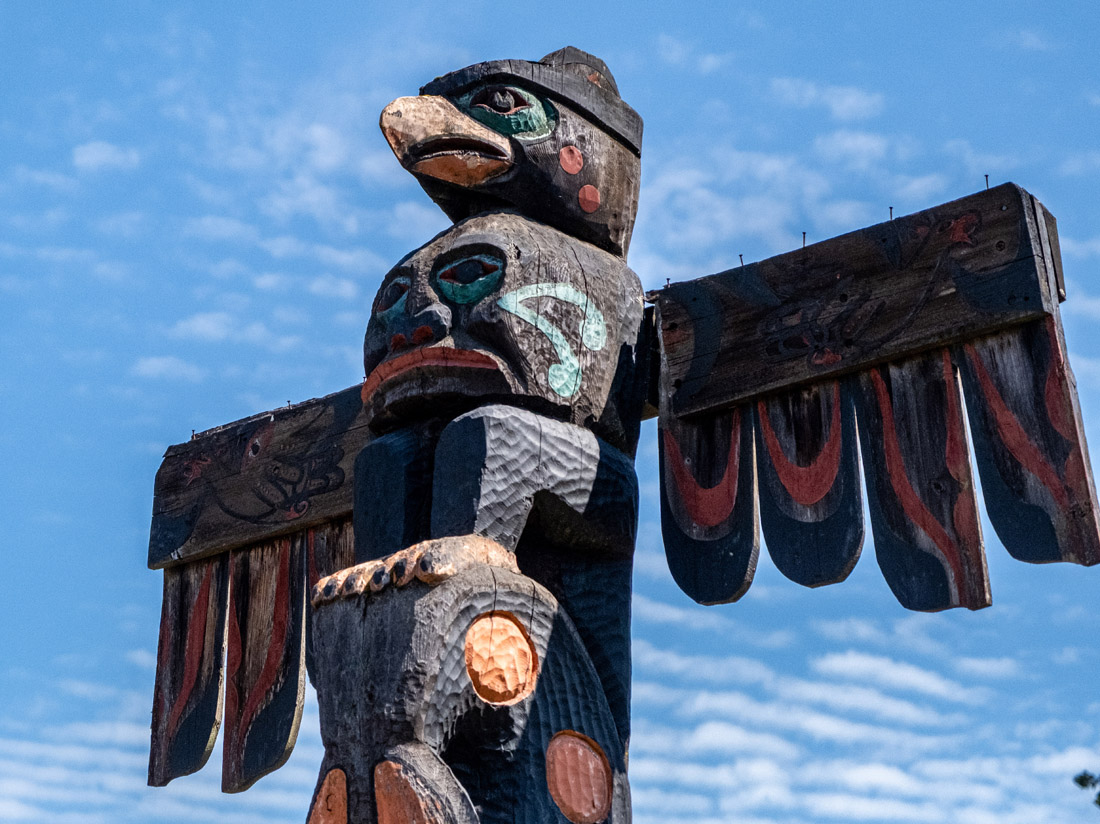
Hwunu'metse' (Simon Charlie)
"The Seal (bottom figure) has the Thunderbird spirit in its tail. Man coming out of the Eagle’s chest is Transformation. He has recognized in his life that how he lives and associates with fellow men, is how he is respected. Eagle is freedom, Salmon is survival, Whale is long life. In the philosophy of Man, these traits are necessary to gain spirituality (Glen Edwards, Submission, 1988)."
"The Whale’s head in the wings signifies the spirit of the Whale, and the Salmon spirits are seen in its legs. The Seal is representative of the sea, the Thunderbird is spiritual. When figures have their tongues out they are sharing a spirit…red is respect for life and black holds it together, gives it solidity. The Eagle has its wings up, like your arms up high; the Eagle can fly high and would carry your prayers (Herb Rice, Interview, Oct 2012)."
* * *
View this pole's entry on the City of Duncan's website.
37. Transformation
Laverne Roy "Corky" Baines
This remarkable pole draws the viewer in. The expressions on the figures convey a range of emotions. The eagle's deeply carved wings makes it seem like it could take flight at any moment.The lack of paint lets this piece of ancient red cedar speak for itself. This pole was carved by Laverne 'Corky' Baines, who was born in Chemainus. With this totem Corky is telling the story of Transformations.
* * *
"Our people believe that there was an undersea world, and you went and put on your killer whale and then you went into the ocean and you lived in the undersea world as part human but also as the whale and then when you came up you took it off… and the killer whale is actually, a symbol itself of transformation because on the fluke of the whale, you’ll see a carved face, and that face represents the wolf and the killer whale will come up onto land and it will change into the wolf and hunt on the land as a wolf. And then it will go back and it will change into the killer whale and hunt in the ocean."
This transformation was doubly significant for Corky, who had been a fisherman before becoming a carver at 34.
"Because Corky was a natural artist, natural ability, his first carving was an eagle, and he did it with a pocket knife, and it was just, you could reach out and touch it, it was so beautiful. And some people I think are born with the ability, and some people have to struggle to get it, they can do it, but they have to struggle, but Corky, he didn’t struggle, he just did art, it was his life."
Sadly, Corky passed away only five years later, just a year after he carved this pole.
Look again at the eagle and think about the significance it had for Corky.
"When Corky did the eagle he had a strong affinity with the greater spirit or God, he never said God, he called it the greater spirit. And he always used to say when I come back into this , I’m coming back as an eagle. And the eagle was very symbolic for him and of course in the transformation and life…. I think if he would have lived he would have, he would have been one of the greatest artists now."
View this pole's entry on the City of Duncan's website.
38. The Friendship Pole
Cicero August
Second from left in this grouping is the Friendship Pole, carved by Cicero August, a master carver from Samuna', one of the Quw'utsun' Tribes.
Cicero's bold use of colour brings these figures to life. The brightly-beaked eagle holds vigil atop the pole, while beneath sits a bear with a salmon clasped in its paws. The bear can be identified by its short snout, small ears, large toothy mouth, and tongue that protrudes between its sharp incisors.
* * *
"The eagle is the protector, he watches over us from the sky. The Bear symbolizes the strength of the tribe. The people live with the salmon all year round. It nourishes the people. The Salmon is smoked and salted and put up for sustenance."
Cicero August was born in 1940 and passed away since. He began carving under his grandfather's tutelage when he was just eight years old, carving ever since. His skill is exhibited in monumental works like this pole and the Knowledge Pole, which now stands in front of BC's Legislature. A distinguishing feature of his poles is that they are tool-finished, rather than sanded down—the technique used by most carvers.
He is also highly acclaimed for carving canoes, paddles, and small ritual objects, for which the traditional Coast Salish style is best known. These include masks, talking sticks, and healing rattles. August continued the tradition and passed his knowledge on to his children. Indeed, his two sons Doug and Darrell, helped him carve this pole.
View this pole's entry on the City of Duncan's website.
39. Owl Pole
Khut Whee Mul Uhk (Dr. Francis Horne Sr.)
This pole was carved by Dr. Francis Horne Sr. and is called the Owl Pole. An owl stands vigil at the top, scanning the horizon. Beneath is a mother bear, speu'th, representing strength, hugging her child close in a protective embrace. The Owl is the Horne family crest, and represents wisdom.
* * *
Totem poles, or house posts in the case of the Coast Salish, were typically commissioned by families to showcase their family history, stories, and crests. Historically, the poles were erected in front of a bighouse to affirm the lineage, prestige, and social rank of the occupants to an audience that was assumed to be well-versed in the culture and mythology of the Northwest Coast.
Every figure on a totem pole or house post is filled with multi-layered meaning, and every crest has a venerable story behind it. For the family that has rights to a crest, they are a great source of pride and honour. A family can have several crests, and they are passed down from generation to generation through the eldest son.
This is the first of five poles by Dr. Francis Horne Sr. that we will see on this tour. He is Coast Salish, and was born in 1954 to a Tsawout mother, from Saanich, and a Lummi father, from Washington state. Growing up on Vancouver Island, he began teaching himself to carve at the age of 18, and became a master carver over the course of a more than half-century long career. Four of his brothers became esteemed carvers in their own right. Two of them, Doug and Tom Lafortune, also carved poles seen on this tour.
View this pole's entry on the City of Duncan's website.
40. Kwagu'ł Bear Holding a Seal
Gwe-la-y-gwe-la-gya-les (Richard Hunt)
This striking pole is called Kwaguʼł Bear Holding a Seal, by the master carver Richard Hunt. He modeled it on a house post carved by his father, Henry Hunt, for the Kwaguʼł big house at Thunderbird Park in Victoria.
* * *
To grasp this pole’s significance, start with Richard Hunt’s roots: born in Yalis (Alert Bay), a Kwakwa̱ka̱ʼwakw village off Vancouver Island, but lived in Fort Rupert, B.C. until moving to Victoria at age two. This community became a lifeline for totem pole carving.
In the 19th century, colonial policies sought to erase Indigenous cultures. Children were forced into residential schools, severing ties to language and tradition. Totem carving, once taught through years of apprenticeship, nearly vanished as elders died without passing on their knowledge.
In the 1920s an anthropologist wrote: "Totem poles are no longer being made…because the Government at the time outlawed potlatching , carving and culture. This art now belongs to the past." Another anthropologist concluded: "pole carving will probably die out with the death of the remaining carvers." In reality, carving and culture didn’t really die out, but rather went underground for a while.
Yet Yalis defied this fate. Against all odds, carvers like Mungo Martin—trained traditionally in the early 1900s—kept the craft alive. By 1950, the government reversed course, hiring Martin to revive the art and at Thunderbird Park at the Royal BC Museum he accomplished just that. Richard Hunt feels that Thunderbird Park should be a National Heritage Site because this is where the culture was actually revived. Mungo Martin trained new apprentices, sparking an artistic renaissance.
This pole embodies that survival. Its carver, Richard Hunt, was one of Martin’s protégés. Without Yalis’ resilience and Martin’s tenacity, these traditions might have vanished—making Hunt’s work a living thread to the past.
View this pole's entry on the City of Duncan's website.
41. Transformation in Life

Chief Swaletthul't'hw (Harvey Alphonse) and Nelson Canute
This totem pole is located inside Duncan City Hall. During work hours you can go inside and see the pole at the rear of the main floor.
An accompanying video for this totem pole is in development.
Hwunu’metse’ (Simon Charlie) carved this pole in 1957 for Lloyd and Frances Hill, of Hill’s Koksilah Stores Ltd, who donated it to the Cowichan Valley Museum & Archives in 1986. The City of Duncan contracted Simon to restore the pole in 1987. In a 1986 interview with architect and Cowichan Historical Society member Shane Davis, Simon explained:
“The pole is a memorial pole with the upper frame representing the Burial Box. The aged climbed into a box (coffin) as their end drew near and after death would be mounted atop the pole. The lower bear figure carries the treaty scroll signed by the Natives and Whites or government officials. The memorial frame surrounds the sun and shows eagles and ravens which depict the spirits or helpers of the soul. [The] pole is a copy of an earlier pole carved to commemorate the treaty signing.”
The figure of a Goat, with horns, is depicted in a sitting position. Hair from goats was woven into textiles, especially blankets. Goat hair caught on the branches of berry bushes when they were grazing during berry picking season, and was plucked from the bushes by weavers. Utilitarian spoons carved from the horns were used daily for eating ooligan (a kind of fish) grease. Many families still use goat horn spoons today for the grease.
* * *
View this pole's entry on the City of Duncan's website.
42. Rick Hansen Man in Motion Pole
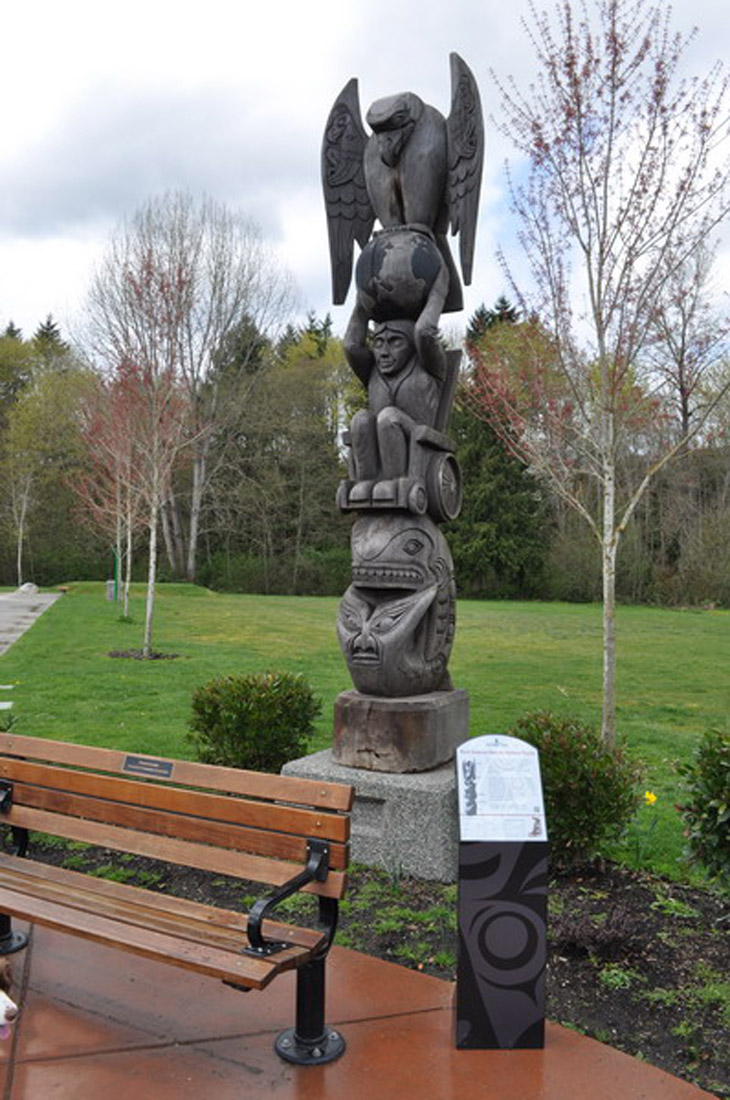
Laverne Roy “Corky” Baines
Sacred legends of the Quw'utsun' people are represented in this pole. Chief Tzouhalem is dressed in the regalia of a Salish Spirit Dancer: a hair hat, a paddle jacket and a kwutsmin staff decorated with deer hooves. These regalia are still used in Salish winter dance ceremonies. The flood story is represented by the figure of the Frog and is a central legend of the Quw'utsun' people.
Simon was asked to put a Grizzly Bear on the pole, but he said they do not inhabit this area; the Province insisted. So not to offend the spirit of the Grizzly Bear, and show that it would be an honoured guest he put a pile of blankets underneath; a traditional way for the Coast Salish to honour an invited guest (Simon Charlie, Macnair Report, 1999).
"The quality of this pole is exceptional as it represents a period of time in which Simon Charlie produced his best work (Judy Hill, Letter, Nov 2002)."
* * *
View this pole's entry on the City of Duncan's website.
43. Provincial Route of the Totems Pole
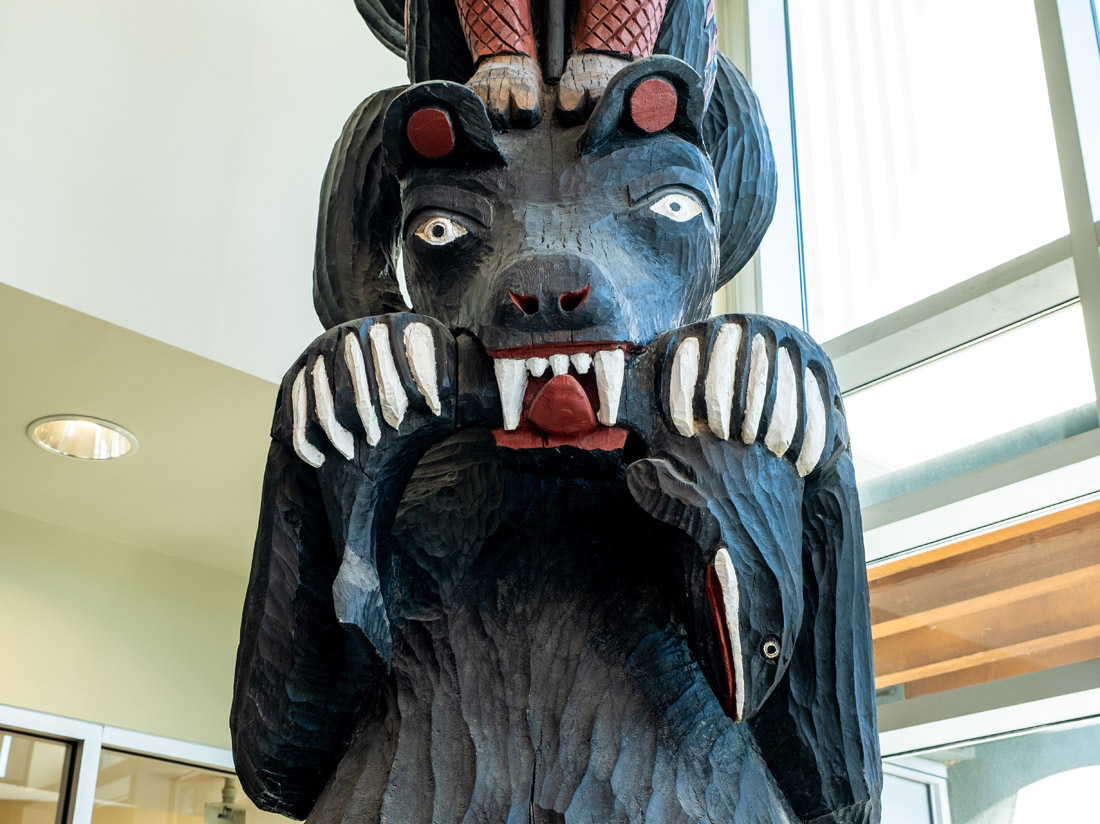
Hwunu'metse' (Simon Charlie)
"Te Anhio Whio is calling out over the forest with the flute…he was bringing them all in tune to the sound of the forest, the deforestation…he was saying to Tane Hiira that we need to do something about it…in a quiet protest way. Tane Hiira's tongue tells us he is a great orator of wit, comedy, and knowledge. The tongue…tells us of a man’s status, character, and talents. The pendant in the shape of a fish hook, is a good luck charm. The meremere (club) was a close combat weapon; it is now used in our dances to welcome other tribes, people, and dignitaries. Three fingers signifies three baskets of knowledge: etiquette and protocol, creating of Heaven and Earth, spiritual knowledge. The size of his hand and fingers signifies strength (Tupari TeWhata, Interview, Oct 2012)."
The panel behind Te Anhio Whio symbolizes the forest and sea creatures in abstract form. The translation of the pole name is: The Welcoming Pole of the King of the Cedar Forest.
* * *
View this pole's entry on the City of Duncan's website.
44. The Fisherman's Pole
Si-yaaxultun (Donald Smith)
This pole honors the Coast Salish fisherman. He is seen here holding a fishing spear atop the natural fisher of the sea, Q'ul-lhanumutsun, the Killer Whale. The pole represents the two kinds of fishers, as well as the deep connection between the Coast Salish people and the waters they rely on.
* * *
Don’s carving style, while rooted in Coast Salish tradition, is distinctly his own. "The Coast Salish is not as intricately designed as other groups," he said. He expands upon it, by embracing bold, flowing forms and deep carving techniques that cast dynamic shadows across the pole at different times of day. The dramatic curve of the whale’s fluke over its dorsal fin demonstrates his confidence in both Charlie's design and the strength of the cedar from which it is carved.
When humans are depicted on totem poles, they are usually chiefs or figures in mythological tales. This pole, highlighting the everyday life of a fisherman, blends tradition with innovation.
View this pole's entry on the City of Duncan's website.



